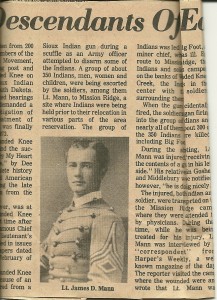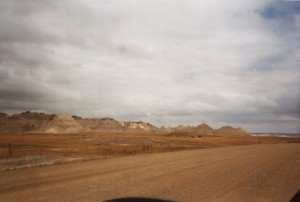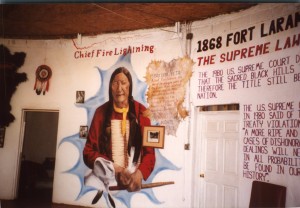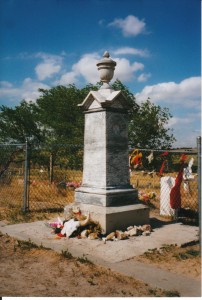Pilgrimage to Wounded Knee
I spent an hour hiking around the grounds of the Mount Rushmore National Memorial, but not seeing Presidents Washington, Jefferson, Roosevelt, or Lincoln. Fog shrouded the mountain and hid the Presidents.
I competed with hundreds of bikers riding through the fog up to Mt. Rushmore on winding Highway 244. The reward for risking a crash in the fog was to see more fog at the viewing sites up the mountain in the Park. Thankfully, there weren’t any wrecks or laid-down cycles on the way up to or on the way back down the mountain with the carved faces of the four dead Presidents.
I wondered about the determination of the hordes of Harley riders braving the fog to reach their desired destination. But then, we Americans are unique in our determination to cross barriers of land and space to reach our goals — whether good for us or not. The Pilgrims and early colonists made the perilous Atlantic crossing to begin life anew in the New World. The Pioneers crossed the Appalachians to clear the forests and break the sod in the Midwest and Great Plains. The gold rushes and land rushes of the West propelled the greedy, the desperate, and entrepreneurial opportunists beyond the Mississippi and over the Rockies. And, by God, we beat the Soviets and everyone else in the space race to the Moon.
The will and courage to cross boundaries, to tame the land and conquer whatever we encountered is one of the great American characteristics. The strength and courage required to begin those journeys is admirable; the results of the conquests, maybe not so much for those who were in our way.
My mind was running down this course over a solitary breakfast at the 1880 Keystone House Family Restaurant in the town of Keystone, South Dakota. Exactly what the hell was I doing here? I hadn’t even seen the images of the four Presidents, nor Crazy Horse. From the unseen stone faces my thoughts had turned to pondering the checkered history and relationship of Americans with the land, the trees, animals, and native peoples who occupied the land before we did. I was seized with a feeling of loneliness and ennui.
I had spent two alienating days in Sturgis, South Dakota during the great biker hajj of Bike Week. Sturgis was just a larger version of other Biker gatherings I’d experienced – macho exhibitionism, sex, drugs, and rock ‘n roll. It had become increasingly clear in the two days I had spent in and around Sturgis that I no longer fit. I had left the tribe and could not return.
I studied my map of South Dakota while eating scrambled eggs and bacon. With map in one hand and fork in the other, I had an epiphany. My eye landed on a place marked “Wounded Knee” on the map. To transform this trip into a meaningful adventure I should perform a spontaneous pilgrimage. I should go to Wounded Knee.
My cell phone battery was almost dead. I turned it off, paid the bill and exited the restaurant. I opened the trunk of the car and stuffed the cell phone into the pocket of my duffel bag. I revved up Goldie, my faithful Sebring, and headed southeast toward the Badlands in a warm, foggy drizzle.
An ancestor of mine died as a result of the “action” at Wounded Knee on December 29, 1890. He was not one of the hundreds of Indians killed in what has come to be considered one of the worst atrocities in the history of the U.S. military. He was one of the perpetrators, Lt. James Defrees Mann of the 7th U.S. Cavalry.
My journalist mother wrote a story for our hometown newspaper, The Goshen News, published in May, 1977, about our ancestor, Lt. Mann. My mom learned about our ancestor when she was invited by the U.S. Military Academy at West Point to represent the family at Lt. Mann’s “Last Roll Call”. The Last Roll Call is the one hundredth anniversary of graduation from West Point. My mom attended the ceremony. Then, she researched Lt. Mann’s military career and wrote the article for the newspaper. I had recently re-read her article while perusing the family scrapbook during a visit with Mom.
It struck me as intriguing and perverse that I have an ancestor who managed to get shot—most likely by friendly fire, since the Sioux weren’t doing much shooting—in one of the most notorious events in U.S. military history. (Another ancestor is Cotton Mather, the prosecutor of the infamous Salem witch hangings. But at least he had the compensating distinction of being a “Puritan Divine”, famed scholar, preacher, and educator. And, he didn’t get killed by a witch during the Witch Trials.) Anyway, my mom’s article was a revelation for me when it was published in 1977; not just about our family history, but also about the “action” at Wounded Knee.
Most of what I had learned about the Indian Wars and conquest of the Plains Indians by the U.S. Army in my American History class in high school was forgotten in the cobwebs of memory by the time I read through my mother’s scrap book. Although, I still remember arguing with one of my teachers, Mr. Clason, about how Americans treated the Natives who got in the way of our “Manifest Destiny” to rule the land from sea to shining sea. Mr. Clason didn’t claim the way the Indians were treated was right, just inevitable. At least he was willing to discuss it, because the mistreatment of Indians was not a favorite topic of public school teachers when I was growing up.
We Americans had circled the wagons to defeat the threat of international communism. We didn’t want to give Castro, Khrushchev, and Mao any extra ammo to use against us by dwelling on past misdeeds of our own. So, most public schools taught us Baby Boomer kids the saccharine-sweet version of American history in our Civics and Citizenship classes.
Re-reading my mom’s article in the new millennium sparked enough interest that I did some further reading on Wounded Knee; including the worldwide best-selling 1970 book Bury My Heart at Wounded Knee by Dee Brown. The book generated tremendous interest in the largely ignored native peoples who had been abandoned to their reservations for the last hundred years. The book was criticized for presenting history only from the Indian point of view and for romanticizing Native American culture. Seems to me though, it was about time the Indian point of view got some attention from the dominant white culture.
A sea change began to occur in 1970 in the popular consciousness of white Americans with respect to the treatment of Native Americans by our forefathers. The movie Little Big Man was also released that year. It starred Dustin Hoffman and was wildly popular. For once, U.S. Cavalrymen were portrayed as the bad guys and Indians as the good guys. Angst within the country about the Vietnam War was at a nadir. The movie subtly but very intentionally compared the way the U.S. treated Native Americans to the way it was conducting the war in Viet Nam.
The conventional view of the dominant white-American culture was that the Plains Indians were unchristian savages who raped and pillaged innocent pioneer settlements. Indians were devious and could not be trusted to live with civilized whites. They needed to be restricted to reservations in order to keep the peace and protect white people. This narrative had some basis in historical fact and received plenty of print and propaganda prior to and up through the 1960’s. Alternative interpretations of history were out there, but were minority reports given little attention.
Growing up in the late 1950’s and 60’s, whenever neighborhood kids played cowboys and Indians, which we often did, the Indians were always the bad guys. We had to take turns being bad guys, so that we got our turn being John Wayne-like good guys. Where did kids in Goshen, Indiana get the idea that the Indians were the bad guys and the cowboys the good guys?
Losers don’t usually get to write the history that is imbibed by the descendants of the winners. But change was afoot by 1970. The new narrative of the wise and noble Indian (e.g., Big Chief in the 1975 film of Ken Kesey’s One Flew over the Cuckoo’s Nest) might have excessively romanticized Native Americans. But, it was about time history was revised and popular consciousness evolved to incorporate the Indian point of view.
An Englishman I met on a recent trip to Wells, U.K. remarked to me that we have such “delightfully colorful-sounding names in the U.S., like Suwannee, Wawasee, and Wapahani.” I replied, “Yes, we Americans are grateful to the Indians for bequeathing us their land along with the names that went with it.” As the winner of the Indian Wars, we whites got to write the history and name the lands we won. Apparently, we liked the sound of Indian names for lakes and rivers, since we kept them. We just didn’t want the people around who named the landmarks.
There is no longer any dispute among historians that what happened at Wounded Knee on December 29, 1890 was one of the worst of the many terrible events in the sad history of Native American encounters with whites in the nineteenth century. My mother’s 1977 article summarized the accepted account of what happened at Wounded Knee. She described it as a massacre of Indians. But her article also related our ancestor’s version of the events.
Lt. Mann might be the only casualty of U.S. Cavalrymen in “the action”. The article describes and quotes a contemporary report about what happened in what was then called “the Battle of Wounded Knee”. Lt. Mann was actually interviewed by a reporter from Harper’s Weekly after the battle while he lay dying from his wound. The Harper’s article was also printed in Lt. Mann’s hometown newspaper, the Goshen Democrat, after the Lieutenant succumbed to his wound and died on January 15, 1891. My mother’s 1977 article in The Goshen News summarized Lt. Mann’s interview by the Harper’s correspondent as follows:
“Lt. Mann was lying on his back with a bullet through his body. The young officer grew stern when he got to the critical part of his story. Lt. Mann said, ‘I saw three or four young bucks drop their blankets and I saw they were armed.’ ‘Be ready to fire men,’ I said, ‘there is trouble.’ There was an instant and then we heard firing in the center of the Indians. ‘Fire,’ I shouted, and we poured it into them.”
There is still disagreement among historians as to who fired the first shot. My mother’s article relates that a gun accidentally went off while Indians were being disarmed by the government troopers. Lt. Mann blamed “an old medicine man” for stirring up “the bucks”. Although the Indians were surrounded by heavily armed government forces, Lt. Mann claimed that the medicine man stoked defiance and the Indians believed they were invulnerable to the bullets of the whites because they wore “ghost shirts … painted with magic symbols.”
Whoever fired the first shot, as my mother’s article notes, the result was that federal soldiers killed around 300 Sioux, mostly women and children.
As far as I know, no one from my family had made a pilgrimage to the place where our ancestor was shot while participating in the massacre. The epiphany I had while studying my map over the course of my solitary breakfast in Keystone, South Dakota was that I should be the first. Perhaps a pilgrimage to Wounded Knee by a descendent of Lt. Mann would qualify as some sort of atonement.
In retrospect, my “epiphany” seems more than a little presumptuous, really quite self-righteous and pretentious. But it felt right at the time. Plus, I figured a pilgrimage to Wounded Knee would relieve the anomie and alienation of Sturgis.
It is shocking and dispiriting to see first-hand the land the U.S. government “gave” the Lakota, Oglala, and Rosebud Sioux for their reservations in the Badlands. We didn’t even reserve all the land for the tribes, because the government also cut out a major chunk of the Badlands for Badlands National Park.
This was the first time I had seen this part of America, southwest South Dakota. Driving across this stark and bleak land, so different in its dry and rocky grayness from the rolling green of my Midwestern homeland, it seemed like it must have been a cruel inhumane joke of the government to have “reserved” this land for the Sioux people. The cruelty of the joke seemed especially poignant as I drove through Custer County.
While there is beauty in the land to some eyes, it has to be indisputable that the Badlands are one of the most inhospitable areas in North America to human existence. The landscape was harsh, grim, and the August heat was terribly oppressive as I motored along State Road 40; too hot to enjoy the convertible top down. It was bad, yeah man, it was a bad land.
The cruelty of the joke on the Sioux manifested itself in another way as I drove on. State Road 40 was a rough but decently paved and maintained road angling southeast from Keystone toward the Pine Ridge Reservation. When it became a BIA (Bureau of Indian Affairs) road, it ceased to be paved. Smackity smackity — poor Goldie endured forty miles of gravel whacking her undercarriage and wheel wells as we motored across the Pine Ridge Reservation. Pavement appeared again when we entered the Badlands National Park.
The sole ranger at Badlands National Park Visitors Center looked the part in his green Parks Service uniform. He was tall, lanky, and had the weather-beaten but reliable look of Gary Cooper. He told me I might be disappointed visiting Wounded Knee. He laconically explained that “there’s not much there.” Turned out, he was right. But then, there wasn’t much there anywhere in the Badlands.
On the east side of the road at the site of the massacre were a couple forlorn booths with beaded belts, necklaces, and other handcrafts for sale. An old Indian in a stained white t-shirt with a Fruehauf Truck cap shading his eyes was asleep on a metal folding-chair behind one booth. A couple kids played in the dirt beside the other booth. On the west side of the road was a circular-shaped wood and concrete building. It was the headquarters for the American Indian Movement (“AIM”).
Inside, the walls were covered with posters and propaganda for AIM. There were testaments to Russell Means and Leonard Peltier. There were newspaper articles and scrapbooks about the demonstrations, minor insurrections, and violence perpetrated against and by AIM. The sparsely furnished interior had a long counter with an aged metal cash register, rickety tables with T-shirts, books, and handmade trinkets for sale. There were no artifacts to commemorate the massacre at Wounded Knee. Only a couple dusty books on a display table referenced the tragic history ending with the 1890 slaughter of mostly defenseless Indians.
Behind the building were two small hillock-like mounds. On top of each mound was a small cemetery. I looked around both graveyards, but didn’t see any monument to those who died in the Battle of Wounded Knee. An elderly Indian wearing a faded cowboy hat, dirty jeans, and stained t-shirt was leaning against the AIM headquarters smoking a hand-rolled cigarette. I asked him if there was a monument to those who were killed at Wounded Knee by the U.S. Cavalry. He looked me up and down without expression. Then, he pointed toward a fenced area of about ten feet by six feet near the back of the closest cemetery to the AIM building. I thanked him. He made no reply.
Within the fenced area was a six-foot high granite monument with names of victims and a description of the massacre. Although my mother’s article reported 300 of the 350 Sioux at Wounded Knee were killed, I counted fewer than 40 names on the monument. The skull of a horned steer rested at the base of the monument. There was some broken pottery, a few faded flowers, ribbons, and a couple fake gold tokens scattered around the base of the monument beside the weather-beaten skull.
I placed two stones on top of the steer’s skull. I wanted to think of it as an offering of symbolic atonement. The gesture was ridiculously presumptuous. I did it anyway.
I had purchased the rocks for one dollar each from two Oglala Sioux kids at the intersection of two gravel roads within Pine Ridge Reservation. Their father told me he wanted to “encourage entrepreneurship” among his kids. Apparently, the only goods and services the father and sons could come up with as an entrepreneurial venture were rocks. Dad told me the kids find rocks, polish them, and sell the shiny stones at road intersections in the reservation.
That the father and his sons were trying to sell rocks to passersby seemed both brave and sad to me. Brave and sad also described what I had learned of the Sioux resistance to the irresistible force of the whites’ sweep across the Great Plains. It seemed appropriate to give back those two brave and sad little stones to the land my ancestors had taken from the Sioux.
________________
Copyright 2012, Jeff Rasley







To complete the story, readers might be interested in my book, “Pilgrimage: Sturgis to Wounded Knee and Back Home Again, a Memoir” at http://www.amazon.com/Pilgrimage-Sturgis-Wounded-Memoir-ebook/dp/B00B0Q71A0/ref=la_B004Q3D6B2_1_4?ie=UTF8&qid=1358380306&sr=1-4
Drupal is one of these effective software packages
that helps people and businesses publish content on their websites.
Dream – Host is an online hosting company that offers products like domain registration, shared website hosting, Virtual Private Server (VPS), and public cloud services.
You can be diligent about protecting your website but someone else on the same server might not be.
Well, it can be the biggest war of the ongoing arc of
Bleach. This technique will also increase the appeal of
your house. Putting these two hobbies together, he decided he wanted to make his own video game involving monsters that you can capture
and use against other people’s.
If you have attempted to market products, solutions or
a enterprise opportunity via your web site, by way of classic techniques of marketing like article advertising, paper click,
blogs or social media, then you know how frustrating this can grow to be.
After looking into a handful of the articles on your blog,
I seriously like your technique of writing a
blog. I book-marked it to my bookmark site list and will be checking back in the
near future. Please visit my web site too and let me know your opinion.
Thank you, I have just been looking for info
approximately this topic for a while and yours is the greatest I have discovered till now.
But, what in regards to the bottom line? Are you positive in regards to the supply?
Everyone loves what you guys are usually up too. This kind of clever work and exposure!
Keep up the fantastic works guys I’ve you guys to my own blogroll.
You could definitely see your skills within the work you write.
The sector hopes for even more passionate writers like you who aren’t afraid to say how they believe.
All the time follow your heart.